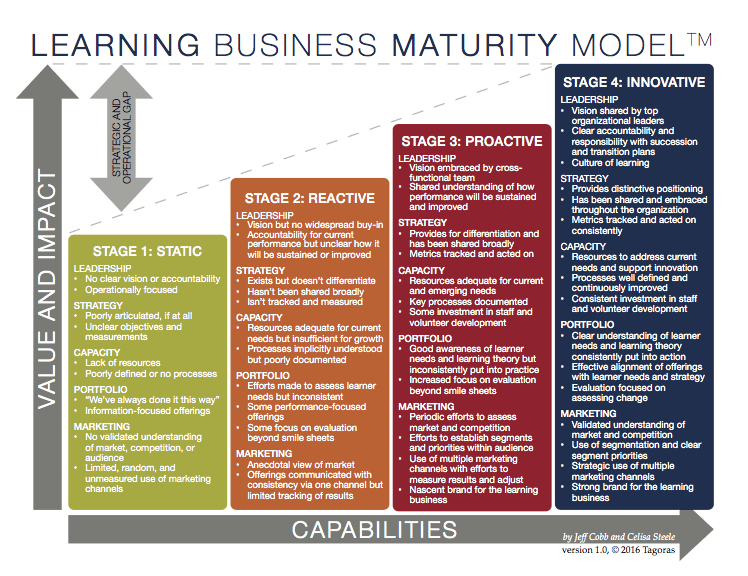
We often talk about the importance of innovation to help learning leaders ensure that their education businesses both survive and thrive in the rapidly evolving learning business landscape. But in order to innovate and move an organization forward, it’s crucial to first have a strong grasp of where you are now.
That’s why we developed the Learning Business Maturity ModelTM , a tool that provides a framework to help organizations assess the maturity of their learning and education businesses and identify areas for improvement and growth. The goal of the model aims to move behind the theoretical and address the practical questions about how a learning business can improve – and here’s the magic word – innovate.
The Learning Business Maturity Model is more than a learning maturity model and it’s more than a business maturity model. It combines the two specifically for organizations in the business of continuing education, professional development, and lifelong learning. In this episode of the Leading Learning podcast Celisa and Jeff explain how to use the maturity model, why they developed it, and how they see it evolving over time.
To tune in, just click below. To make sure you catch all of the future episodes, be sure to subscribe by RSS or on iTunes. And, if you like the podcast, be sure to give it a tweet!
You may also want to see/listen to:
And if you are interested in implementing the model in your learning business, be sure to find out about the Tagoras Maturity Accelerator Program.
Listen to the Show
Read the Show Notes
[00:20] – Thank you to Avilar, which as the sponsor of our upcoming Webinar, LMS Selection: Mastering the Process, Avoiding the Pitfalls is also the sponsor of this episode of the Leading Learning podcast.
Learning Business Maturity Model
[00:49] – Note that the Learning Business Maturity Model (version 1.0) was first introduced at the Leading Learning Symposium and we are now making it more broadly available.
The Learning Business Maturity Model articulates the characteristics and practices of a mature learning and education business or line of business, as well as the stages that typically precede full maturity.
It is intended specifically for market-facing organizations or units within such organizations that focus on lifelong learning, continuing education, and professional development. It is not intended for corporate training departments or degree-granting programs, for example.
Why a Maturity Model?
[2:08] – Jeff explains they developed this because, over their years of working with market-facing learning businesses, they’ve seen common problems/issues and opportunities—and opportunities that those organizations often don’t see because they’re too mired in their problems.
Lastly, he says they haven’t seen enough collaboration among organizations (one of the reasons for starting the Leading Learning Symposium) and they wanted to provide a model that could be used broadly for any business in the world of continuing education and professional development to hopefully help them to innovate.
[03:09] – The goal of the Learning Business Maturity ModelTM is to provide a framework to assess capabilities and to help surface problem areas – and then provide a clear way to move from problem to opportunity and from there, towards innovation.
The downloadable (PDF) version of the model contains an assessment to help learning businesses gauge their maturity to better understand their strengths and weaknesses in areas such as leadership, strategy, resources, products and services, and marketing.
The goal of the model aims to move behind the theoretical and address the practical questions about how a learning business can improve. Jeff adds that the model is also a way to help market-facing learning businesses more fully recognize they are part of a distinct sector, linked by the shared goal of serving a market through learning—and they can learn from each other.
A High-Level Look at the Maturity Model
[04:21] –The Learning Business Maturity Model spans four stages of maturity:
- Stage 1: Static
- Stage 2: Reactive
- Stage 3: Proactive
- Stage 4: Innovative
In each stage, we gauge maturity according to characteristics and performance in five domains we’ve found to be critical to the success of the learning and education businesses we’ve have been involved with over the years.
[05:11] –In cases in which the learning and education business is part of a larger organization—as it is with many trade associations and professional societies—the model deals with five domains in the context of the learning and education line of business, not the entire organization. The five domains include:
- Leadership – How clear is the vision for the learning and education business? How is accountability for achieving the vision shared and sustained over time? Is there a culture of learning throughout the organization and its audience?
- Strategy – How clearly articulated is the strategy? Has it been communicated and embraced broadly throughout the organization? Are clear metrics established and tracked, and does the organization adjust strategy based on the data captured
- Capacity – Does the organization have sufficient capacity, in terms of human resources and technology, to pursue the vision and strategy effectively?
- Portfolio – Are the content, methodologies, and modalities aligned with well researched, thoroughly understood learner needs? Is the impact of learning assessed at multiple levels over time?
- Marketing – Is there a validated understanding of the overall market and competitive environment? Are appropriate marketing methodologies used consistently and tracked for effectiveness?
[07:02] – For each of the stages, we tried to capture a snapshot of what an organization that is fully in that stage might look like. However, we realize that an organization might be in one stage in one domain but another stage in a different domain so it is the combined score they get from the assessment that will put them into a particular stage on the maturity model. Each of the generic snapshots that define the stages of maturity (static, reactive, proactive, and innovative).
Getting Value Out of the Maturity Model
[11:00] – A discussion about getting value out of the maturity model and thoughts on how the model can be used within the organization. Note the model is extremely valuable as a conversation starter and it’s best for multiple people across the organization to participate in the assessment to help rate where they are in terms of maturity.
Another useful place to use the model is in board conversations because it helps board members tune into the fact that learning is a business and needs to be viewed and managed as one.
[12:45] – Regarding the future of the maturity model, we don’t consider it final at this point, and it may never be. We plan to make adjustments to it based on feedback from those making use of it in their organization. We plan to develop additional resources (other articles, training, and more) around the model and, more importantly, around the use of the model to improve the reach, revenue, and impact of learning businesses.
Check out Leveraging the Learning Business Maturity Model where we provide additional clarity on how to use the model.
13: 33 – A reminder to download the Learning Business Maturity ModelTM and to make use of the assessment to gauge where your learning business is and to start a discussion with the relevant stakeholders about how you can move learning forward in your organization. Use the button below to access the assessment (free).
We also encourage you to please share your comments and suggestions with us at support@tagoras.com, so we can respond to feedback and, as appropriate, incorporate it into future versions.
[14:59] – Wrap Up
Thanks again to Avilar for sponsoring of this episode of the Leading Learning podcast.
If you are getting value from the Leading Learning podcast, be sure to subscribe by RSS or on iTunes. We’d also appreciate if you give us a rating on iTunes by going to https://www.leadinglearning.com/itunes.
Also, please tell others about the podcast. Go to https://www.leadinglearning.com/share to share information about the podcast via Twitter, or send out a message on another channel of your choosing with a link to https://www.leadinglearning.com/podcast.
[16:45]- Sign off
See Also:


Leave a Reply